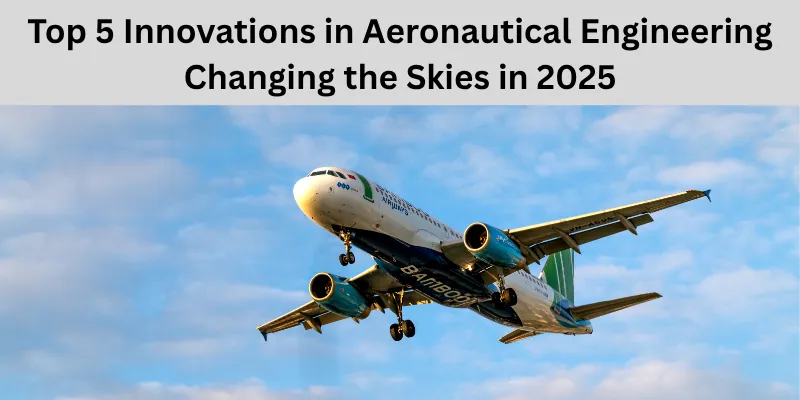

What if your next flight were powered by hydrogen and guided by AI? In 2025, aviation is reaching new heights with groundbreaking advances in sustainability, autonomy, and smart materials. These innovations aren’t just futuristic—they’re already transforming how we fly.
Let’s explore the top five breakthroughs changing the skies this year.
What once seemed like sci-fi is now real. In 2025, hydrogen-powered aircraft will be flying test missions. Powered by green hydrogen from renewable energy, these planes are moving from concept to reality.
What’s new: Hydrogen fuel cells are proving effective in planes, producing only water vapor—no carbon emissions. Flying could finally go green.
Impact: Aviation emits high CO₂ levels due to traditional jet fuels, but hydrogen offers a cleaner solution without altering how we fly—a game-changer for air travel and the environment.
Case in Point: Airbus is advancing its ZEROe concept to launch the first hydrogen-powered commercial plane by the early 2030s, while regional airlines are already testing hydrogen-powered short-range aircraft.
Why it matters: Hydrogen planes could slash aviation emissions by up to 50%, marking a major step toward sustainable air travel.
Imagine a tireless, mistake-free co-pilot that learns from every flight. In 2025, AI flight systems are doing just that—revolutionizing how planes are flown and maintained.
What’s new in 2025: Artificial Intelligence is now a reality. This year, AI co-pilots and predictive tools are actively used in commercial and military aircraft, analyzing vast data in real time to aid decisions, prevent issues, and cut human error.
Impact: Smarter, Safer, and More Efficient Flights
AI in the cockpit means:
Real-World Application: Boeing is testing AI cockpit assistants to aid pilots during takeoff, landing, and emergencies. Meanwhile, DARPA-inspired systems use autonomous AI to support fighter pilots in combat—like a smart wingman.
Why it matters: AI isn’t replacing pilots—it’s enhancing them. By managing complex tasks, AI lets pilots focus on strategy, communication, and flight control, leading to safer, smarter, smoother flights.
Imagine an aircraft that repairs itself, adapts to changing conditions, and flies farther on less fuel. In 2025, that’s not science fiction—it’s smart material science in action.
What’s new: Engineers are using advanced materials to transform aircraft design and performance:
Impact: These materials make aircraft:
Lighter aircraft = longer range + lower cost + higher performance. It’s a win-win for airlines, engineers, and the planet.
Real Example: In 2025, military drones and experimental jets will already be using these smart materials. They can fly missions for longer periods, adapt to high-stress conditions, and return with minimal wear and tear—saving time, money, and lives.
Why it matters: Smart materials are reshaping the future of flight. They’re not just high-tech—they’re high-impact. As engineers continue to innovate, tomorrow’s commercial aircraft will be smarter, stronger, and more sustainable than ever.
Imagine flying at 35,000 feet and your aircraft is not just a machine — it’s a smart, connected system constantly collecting and sharing data. In 2025, this vision is becoming a reality.
What’s new: Satellites, early 6G trials, and edge computing are turning airplanes into high-speed data hubs, enabling real-time processing and seamless connection to ground teams and other aircraft.
Impact: Advanced connectivity is transforming flight operations:
Flights are now safer, smoother, and smarter.
Mention: Aviation is entering an era where constant connectivity is essential, not optional. From in-flight Wi-Fi to cockpit data systems, it powers modern flight.
Why it matters: Data is quickly becoming aviation’s co-pilot — guiding decisions, spotting issues, and boosting flight efficiency. For airlines, it reduces delays; for passengers, it ensures safer, more personalized trips.
Next time you fly, remember: the real power isn’t just in the engines — it’s in the data behind the scenes.
Imagine flying from New York to London in just over three hours — and doing it without harming the environment. That’s the exciting future of supersonic flight in 2025.
What’s new: Supersonic jets are returning—quieter and greener. New tech reduces their once-disruptive sonic booms, and they're designed to use sustainable fuels, lowering emissions.
Impact: This innovation is transforming travel with faster flights and greener engines, offering both speed and sustainability. Supersonic travel is now a real option for business and leisure alike.
Example:
Why it matters: Supersonic travel in 2025 isn’t just faster — it’s a smarter, more efficient, and eco-conscious way to fly. It shows how innovation in aviation is reshaping air travel and our lives.
The future of flight isn’t just faster jets or smarter planes—it’s about redefining air travel itself. 2025 brought breakthroughs, but there’s more ahead.
Here’s what’s next.
Urban Air Mobility: Beat City Traffic from the Sky
Skip traffic jams with air taxis! Urban Air Mobility (UAM) aims to transform city travel using small aircraft to quickly and quietly move people or packages over short distances.
eVTOLs: Electric Jets That Take Off Like Helicopters
eVTOLs (Electric Vertical Takeoff and Landing aircraft) are compact, eco-friendly jets that lift off like helicopters but run on electricity—ideal for short urban trips and don’t need runways.
Bio-Inspired Designs: Nature as the Engineer
Engineers are turning to nature—like birds and insects—to improve aircraft. Flexible wings, twisting tails, and adaptive surfaces are making planes lighter, quieter, and more fuel-efficient.
Mention challenges ahead (regulation, infrastructure, pilot training).
Despite the excitement, key challenges remain:
Without these, even top tech can’t fully take off.
These five innovations aren’t just improvements—they’re changing the way we fly. Aeronautical engineers today are shaping the future of global connectivity.
Ready to join the revolution? Explore exciting careers and breakthroughs in aviation.
"Which innovation excites you the most? Let us know in the comments!"